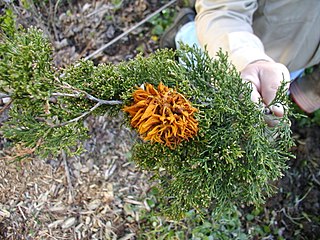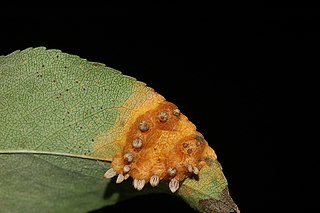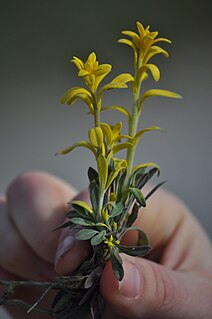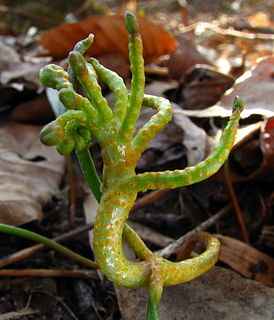
Basidiomycota is one of two large divisions that, together with the Ascomycota, constitute the subkingdom Dikarya within the kingdom Fungi. More specifically, Basidiomycota includes these groups: mushrooms, puffballs, stinkhorns, bracket fungi, other polypores, jelly fungi, boletes, chanterelles, earth stars, smuts, bunts, rusts, mirror yeasts, and the human pathogenic yeast Cryptococcus. Basidiomycota are filamentous fungi composed of hyphae and reproduce sexually via the formation of specialized club-shaped end cells called basidia that normally bear external meiospores. These specialized spores are called basidiospores. However, some Basidiomycota are obligate asexual reproducers. Basidiomycota that reproduce asexually can typically be recognized as members of this division by gross similarity to others, by the formation of a distinctive anatomical feature, cell wall components, and definitively by phylogenetic molecular analysis of DNA sequence data.

In biology, a spore is a unit of sexual or asexual reproduction that may be adapted for dispersal and for survival, often for extended periods of time, in unfavourable conditions. Spores form part of the life cycles of many plants, algae, fungi and protozoa. Bacterial spores are not part of a sexual cycle but are resistant structures used for survival under unfavourable conditions. Myxozoan spores release amoebulae into their hosts for parasitic infection, but also reproduce within the hosts through the pairing of two nuclei within the plasmodium, which develops from the amoebula.

Gymnosporangium is a genus of heteroecious plant-pathogenic fungi which alternately infect members of the family Cupressaceae, primarily species in the genus Juniperus (junipers), and members of the family Rosaceae in the subfamily Amygdaloideae. According to the Dictionary of the Fungi, there are about 57 species in the genus.

Rusts are plant diseases caused by pathogenic fungi of the order Pucciniales.

The stem, black, and cereal rusts are caused by the fungus Puccinia graminis and are a significant disease affecting cereal crops. Crop species that are affected by the disease include bread wheat, durum wheat, barley and triticale. These diseases have affected cereal farming throughout history. The annual recurrence of stem rust of wheat in North Indian plains was discovered by Prof. K.C. Mehta. Since the 1950s, wheat strains bred to be resistant to stem rust have become available. Fungicides effective against stem rust are available as well.

Wheat leaf rust is a fungal disease that affects wheat, barley and rye stems, leaves and grains. In temperate zones it is destructive on winter wheat because the pathogen overwinters. Infections can lead up to 20% yield loss, which is exacerbated by dying leaves, which fertilize the fungus. The pathogen is Puccinia rust fungus. Puccinia graminis causes "stem or black rust", P. triticina causes "leaf or brown rust", and P. striiformis causes "strip or yellow rust". It is the most prevalent of all the wheat rust diseases, occurring in most wheat growing regions. It causes serious epidemics in North America, Mexico and South America and is a devastating seasonal disease in India. All three types of Puccinia are heteroecious requiring two distinct and distantly related hosts. Rust and the similar smut are members of the class Pucciniomycetes but rust is not normally a black powdery mass.

Teliospore is the thick-walled resting spore of some fungi, from which the basidium arises.
Gymnosporangium globosum is a fungal plant pathogen that causes cedar-hawthorn rust.

Gymnosporangium juniperi-virginianae is a plant pathogen that causes cedar-apple rust. In virtually any location where apples or crabapples (Malus) and Eastern red-cedar coexist, cedar apple rust can be a destructive or disfiguring disease on both the apples and cedars. Quince and hawthorn are the most common host and many species of juniper can substitute for the eastern red cedars.
Puccinia schedonnardii is a basidiomycete fungus that affects cotton. More commonly known as a “rust,” this pathogen typically affects cotton leaves, which can decrease the quality of the boll at time of harvest. As large percentages of cotton in the United States are resistant to various rust varieties, there is little economic importance to this disease. In places where rust is prevalent, however, growers could see up to a 50% reduction in yield due to rust infection.

Puccinia asparagi is the causative agent of asparagus rust. It is an autoecious fungus, meaning that all stages of its life cycle – pycniospores, aeciospores, and teliospores – all develop upon the same host plant . Rust diseases are among the most destructive plant diseases, known to cause famine following destruction of grains, vegetables, and legumes. Asparagus rust occurs wherever the plant is grown and attacks asparagus plants during and after the cutting season. Asparagus spears are usually harvested before extensive rust symptoms appear. Symptoms are first noticeable on the growing shoots in early summer as light green, oval lesions, followed by tan blister spots and black, protruding blisters later in the season. The lesions are symptoms of Puccinia asparagi during early spring, mid-summer and later summer to fall, respectively. Severe rust infections stunt or kill young asparagus shoots, causing foliage to fall prematurely, and reduce the ability of the plant to store food reserves. The Puccinia asparagi fungus accomplishes this by rust lowering the amounts of root storage metabolites. The infected plant has reduced plant vigor and yield, often leading to death in severe cases. Most rust diseases have several stages, some of which may occur on different hosts; however, in asparagus rust all the life stages occur on asparagus. Because of this, many observers mistake the different stages of the Puccinia asparagi life cycle as the presence of different diseases. The effects of Puccinia asparagi are present worldwide wherever asparagus is being grown. Asparagus rust is a serious threat to the asparagus industry.

Puccinia menthae is a fungal plant pathogen that causes rust on mint plants.

Gymnosporangium sabinae is a fungal heteroecious plant pathogen with Juniperus as the primary (telial) host and only Pyrus as secondary (aecial) hosts. It is one of many types of rust fungi affecting plants.

Puccinia monoica is a parasitic rust fungus of the genus Puccinia that inhibits flowering in its host plant and radically transforms host morphology in order to facilitate its own sexual reproduction.

Telium, plural telia, are structures produced by rust fungi as part of the reproductive cycle. They are typically yellow or orange drying to brown or black and are exclusively a mechanism for the release of teliospores which are released by wind or water to infect the alternate host in the rust life-cycle. The telial stage is one of the stages in the life cycle of a parasitic heteroecious fungus; it is spent on the secondary host plant. A primary aecial stage is spent parasitizing a separate host plant which is a precursor in the life cycle of heteroecious fungi. Spores are released from the telia in the spring. The spores can spread many kilometers through the air, however most are spread near the host plant.

Puccinia sessilis is a fungal plant pathogen, also known as arum rust or ramsons rust. It commonly infects Arum maculatum and Allium ursinum causing yellow to orange circular patches on leaves. On the underside it produces raised orange aecia commonly covered in spores. It is common in Eurasia in the spring.

Puccinia mariae-wilsoniae, commonly known as the spring beauty rust, is a species of rust fungus found in North America. A plant pathogen, it grows on the leaves of the spring beauty flowering plants Claytonia caroliniana and C. virginica.

Pine-pine gall rust, also known as western gall rust, is a fungal disease of pine trees. This plant disease is caused by Endocronartium harknessii, an autoecious, endocyclic, rust fungus that grows in the vascular cambium of the host. Pine-pine gall rust is found on pine trees with two or three needles such as ponderosa pine, jack pine, and scots pine. The disease is very similar to pine-oak gall rust, but its second host is another Pinus species. The fungal infection results in gall formation on branches or trunks of infected hosts. Gall formation is typically not detrimental to old trees but has been known to kill younger less stable saplings. Galls can vary from small growths on branch extremities to grapefruit sized galls on trunks.
Phakopsora euvitis is a rust fungus that causes disease of grape leaves. This rust fungus has been seen in regions including: Eastern Asia, Southern Asia, Southwestern Brazil, the Americas, and northern Australia. It is widely distributed in eastern and southern Asia but was first discovered on grapevines in Darwin, Australia in 2001 and was identified as Asian grapevine leaf rust by July 2007.
Melampsora amygdalinae is a fungal pathogen and part of the phylum, basidiomycota. It is known as a rust fungus that is host specific. M. amygdalinae commonly infects willows of the genus Salix. This fungus was first discovered in 1909 by Heinrich Klebahn who was a professor of soil biology in Hamburg. Neimi at el. explain how the pathogen occurs throughout the whole distribution of the host, and the small natural populations are an area of interest. This rust fungus is annual and autoecious, which references the fungus spending its entire life in a single host.

















